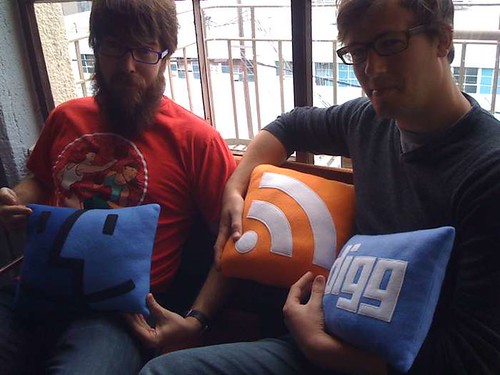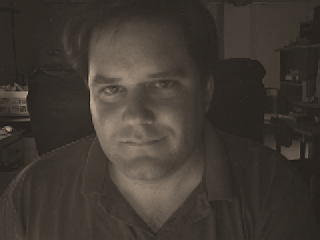Researchers have devised a penny-sized silicon chip that uses photons to run Shor's algorithm - a well-known quantum approach - to solve a maths problem.
The algorithm computes the two numbers that multiply together to form a given figure, and has until now required laboratory-sized optical computers.
This kind of factoring is the basis for a wide variety of encryption schemes.
The work, reported in Science, is rudimentary but could easily be scaled up to handle more complex computing.
Shor's algorithm and the factoring of large numbers has been a particular case used to illustrate the power of quantum computing.
Quantum computers exploit the counterintuitive fact that photons or trapped atoms can exist in multiple states or "superpositions" at the same time.
For certain types of calculations, that "quantum indeterminacy" gives quantum computers a significant edge.
While traditional or "classical" computers find factoring large numbers impracticably time-consuming, for example, quantum computers can in principle crack the problem with ease.
That has important implications for encryption methods based on factoring, such as the "RSA" method that is used to make transactions on the internet more secure.
'Important step'
Optical computing has been touted as a potential future for information processing, by using packets of light instead of electrons as the information carrier.
But these packets, called photons, are also endowed with the indeterminate properties that make them quantum objects - so an optical computer can also be a quantum computer.
In fact just this kind of photon-based quantum factoring has been accomplished before, but the ability to put the heart of the machine on a standard chip is promising for future applications of the idea.
"The way people used to make this kind of circuit consumed square metres of laboratory space and took graduate students many months to align," said Jeremy O'Brien, the University of Bristol researcher who led the work.
"Doubling the complexity of the circuit often times turns it from being a difficult task to a practically impossible one, whereas for us to double the complexity it's really straightforward," he told BBC News.
The Bristol team's approach makes use of waveguides - channels etched into the chips that provide a path for the photons around the chips like the minuscule wires in conventional electronics.
While Professor O'Brien said he is confident that such waveguides are the logical choice for future optical quantum computers, he added that there is still a significant amount of work to do before they make it out of the laboratory.
"To get a useful computer it needs to be probably a million times more complex, so a full-scale useful factoring machine is still at least two decades away," he said.
"But this is one important step in that direction."
Link
Monday, September 07, 2009
Sunday, July 12, 2009
Anti-Theft Lunch Bags

Tired of having your food stolen by sticky-fingered coworkers or roommates? Bullies taking your kid's lunch? Well, worry no more . . . Anti-Theft Lunch Bags are sandwich bags that have green splotches printed on both sides, making your freshly prepared lunch look spoiled. Don't suffer the injustice of having your sandwich stolen again! Protect your lunch with Anti-Theft Lunch Bags.
Ref
Labels:
Gaget
Friday, July 03, 2009
HOW-TO: Installing OSX Leopard, Windows Vista, Windows XP and Linux Ubuntu on a Macbook

1) You will need a format and repartition of the whole disk, so time machine your previous data.
2) Insert OSX Leopard (also Tiger works) Install DVD. Reboot the macbook pressing the C key (so it will boot from DVD). From the "Utilities Menu" window menu select "Disk Utility". From "Volume Scheme" tab, select 5 partitions and use this schema:
2.0- EFI protected (which is invisible under Disk Utility)
2.1- Name: VISTA Format: MS-DOS File System <--create this partition *even* if you don't plan to install Vista, XP partition *must* be the 4th one to avoid missing hal.dll trouble!
2.2- Name: STORAGE Format: MS-DOS File System
2.3- Name: XP Format: MS-DOS File System
2.4- Name: OSX Format: Mac OS Extended (Journaled)
2.5 - Format: Free Space (Linux partitions will be created here later)
Every partition will host its OS. The (optional, but very advidsed) STORAGE partition will be formatted in FAT32 to share files between the four OSes. If you are installing a brand new hard disk, check boot loader type as "GUID Partition Table (GPT)" (remove MBR default or you will not be able to install OS X). Then click the "Partition" button, and all your data on disk will be destroyed.
Now you can close "Disk Utility", and start install OS X to volume "OSX". After reboot into OS X, hou have to install rEFIt boot loader (download it from refit.sourceforge.net) into volume "OSX".
Update: If you have installed "MacBook EFI Firmware Update 1.1" (available via Apple Software Updater) installing rEFIt is no more compulsory if you plan to install linux after on your macbook. This update will fix built-in keyboard issue with "legacy" bootloaders, so you can use grub bootloader included in Ubuntu to boot Vista, Xp and Ubuntu. But I personally installed rEFIt because I really prefer his graphical boot than grub textual one :D
Update: If you want to obtain a triple boot macbook, without installing Vista don't create the VISTA partition on step 2), proceed to step 3a) and ignore 3b). Instead if you want to install Vista, jump directly to step 3b)
3a) You can use directly from OS X terminal the "fdisk" command, that handles an MBR-partitioned disk, to setup the XP partition suitable for installing that windows version. Open a terminal under OS X:
type "sudo fdisk -e /dev/rdisk0"
enter password and ignore the message "fdisk: could not open MBR file /usr/standalone/i386/boot0: No such file or directory"
type "p" to print MBR partition table
type "f " "4" to flag partition 4 active
type "q" to save and quit
3b) Insert Windows Vista install DVD. Reboot the macbook pressing the C key. Install Vista onto partition 2 named "VISTA". You must format it as NTFS at this point. Installation finishes and you have a dual boot Mac.
In Vista, click the "Start" button, click "Control Panel", click "System and Maintenance", click "Administrative Tools", and then double-click "Computer Management". In the Navigation pane, under "Storage", click "Disk Management". Right-click the XP partition, and then click "Mark Partition as Active".
4) Insert Windows XP install CD. You can't install any XP version coming on 2 CDs (like Media Center Edition 2005), only version from a single CD or DVD. So if you want to install MCE 2005 you need the (single) DVD version. Reboot the macbook pressing the C key. Press the enter key when you will read "Press any key to boot from CD". If you boot Vista by mistake, you must mark active XP partition again (because rEFIt will flag Vista as active if you select it).
You will see the VISTA partition marked "D:" and XP partition "C:". Now install XP to "C:". You must format it now (in either NTFS or FAT32) or XP will not boot. At reboot, select the 2nd windows logo "boot from partition 4" to continue install. Installation finishes and you have a (dual)triple boot Mac.
5) Insert Linux Ubuntu install live CD or DVD, (I used Ubuntu Desktop 8.04b AMD64) reboot from it. Launch install from desktop.
- At step 3, choose your keyboard layout as Macintosh.
- At step 4, choose to manually partition the disk:
create a / partition and a swap partition at the end of the disk. (Swap must be larger than memory to be able to "hibernate". And one megabyte here is 1000*1000 bytes, not 1024*1024)
- At step 7, before you go ahead with the install, click "advanced", and tell ubuntu to install GRUB to (hd0,2), the FAT partition. (Yes, this is the right place. Installing GRUB into the MBR will let GRUB manage the windows booting, you will have to go through 2 boot manager to boot windows or linux, which is not what we want. Besides MBR, it seems GRUB can only be installed into among the first 4 partitions to be bootable, and the FAT partition right now doesn't contain a boot code so it's safe to have GRUB live there)
Update: If you don't want to use rEFIt, install GRUB into the MBR. Hold "option" key upon boot to select "Windows", then use Grub menu to boot between Ubuntu, Vista, or Xp.
Proceed with the install. Reboot and you will see 4 OSes from rEFIt menu.
6) Almost done! Now install hardware drivers in each OS, in both Windows installation insert Leopard install disk 1 and install bootcamp drivers to make touchpad, iSight and so on perfectly working under both Xp and Vista.
Link
Labels:
Macbook,
OSX Leopard,
Ubuntu,
Vista,
Windows
Sunday, June 28, 2009
Michael Jackson, king of pop and ... inventor?

MJ always had a reputation for putting on a good stage show, but did you know that some of the equipment he used was so creative as to warrant a patent? In the “Smooth Criminal” video, everyone on the stage ends up leaning over at a 45 degree angle at one point, something that is normally not possible. But instead of being held against the stage by the pure power of funk, Jacko actually invented a very special shoe to help pull off the trick.
If you view the patent, you’ll see that the sole of the shoe had a very special notch and plate in it, and unbeknown to the public, there was a steel peg in the stage that allow the dancers to lock the special shoe down to hold their weight. Pretty amazing stuff.
Here’s the video, if you watch at 3:53, you can see the shoes in action. Also, watch the guy on the right, he has problems disengaging from the floor.
Ref.
Labels:
Inventor,
Michael Jackson,
Pop
Saturday, June 27, 2009
Security : Laser Bike Protection Lane
The personal bike lane consists of strips of laser-light projected onto the asphalt. This provides a psychological barrier to other road users, hopefully giving the cyclist a little extra breathing space.
Sunday, June 14, 2009
Thursday, June 11, 2009
Subscribe to:
Posts (Atom)



